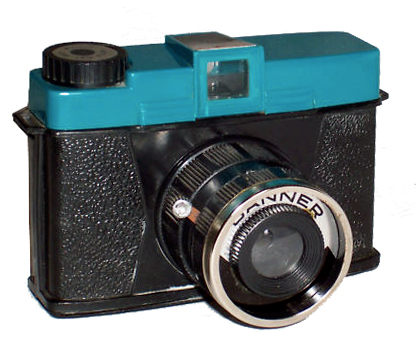Greg Neville, 2010.
Altered National Australia Bank billboard at Preston market, 2010.
Month: July 2011
A party in my car
The fight
Stop Ugly
My Life in Cameras no.15
15. BANNER
The Banner is a strange device. A clone of the classic Diana camera of the 1960s and 70s, it was produced by the Great Wall Plastic Co. of Hong Kong to be sold as toys, promotional giveaways, fairground prizes etc. Diana is the generic name of the cheap cameras produced mostly on the same assembly line, with different labels and minor modifications.
It is a primitive tool. It has almost no adjustments, annoying light leaks and dark corners due to the mismatch between the circle if illumination and the negative area. The technical flaws – the soft-focus lens, the colour fringeing, the flare and the dark edges all create a unique visual quality, a sort of instant Pictorialism. Like the Diana and the Holga, it’s a sort of subversive photography, a protest against the hi-tech precision of digital.
In addition to the Banner, there were also Diana clones called Banier, Anny, Acme, Arrow, Harrow, Liking, See, Tina, Debonair, Megomatic, Future Scientist and North American Champion. The website www.allandetrich.com has a list of over 100 clones with photos and information. Detrich has also produced a Blurb book called Diana Camera Pictorial History which shows each camera. He had probably the largest Diana collection in the world until he sold it to the Lomo company as a museum piece. Vintage Banner/Dianas are a bit rare, but Lomo now make their own “clone”, a Diana rebirth engineered with modern techniques to replicate the original. The original price of a Banner in the 60s was less than $5. They can now fetch hundreds. The Lomo Diana retails for US$52. The world has gone mad.
The Banner is a primitive tool. It has almost no adjustments, annoying light leaks and dark corners due to the mismatch between the circle if illumination and the negative area. The technical flaws – the soft-focus lens, the colour fringeing, the flare and the dark edges all create a unique visual quality, a sort of instant Pictorialism. Like the Diana and the Holga, it’s a sort of subversive photography, a protest against the hi-tech precision of digital.
Greg Neville, Milan 2000
Greg Neville, Milan 2000
Greg Neville, Milan 2000
My Life in Cameras no.17
17. HOLGA
The Holga was created in 1981 by a Mr.T.M.Lee as a cheap family camera for the Chinese market, a sort of modern Box Brownie. It wasn’t exactly a “toy” camera as it’s sometimes labelled now. When 35mm caught on there and the market dried up, it started to catch on among experimental users in the West. Like its soulmate the Diana, it is now a phenomenon with competitions, flickr groups and elaborate new models aggressively marketed by its current owner Lomo.
The Holga is a hardy camera but it has its handicaps: a slightly soft focus lens which doesn’t quite cover the 6×6 negative causing dark corners or vignetting. It leaks light sometimes and the back constantly falls off. It has the bare minimum of adjustments, two apertures and one shutter speed, which means that if your subject is outside of 1/100 of a second at f8 or f11 you’ll be in trouble. It does focus, but only using symbols. Wikipedia calls this a “low fidelity aesthetic.”
Part of the secret is the 60mm focal length lens, a moderate wide-angle which particularly suits the architectural subjects I shoot. The camera changes from square format to 6×4.5 rectangular format with the insertion of the plastic plate, but this loses the vignetting which is part of the camera’s inherent look.
I bought my Holga at the International Centre of Photography in New York and took photographs of skyscrapers, see the first image below. These were shown in an exhibition called Vertigo, with Greg Wayn in 2004. This led to a much larger Holga project called The Modern Idea, about modernist architecture around the world (other images below). You can see Vertigo and The Modern Idea on my website Modernismus.
When photographing in New York, an African man came up to me and asked what camera I was using. “It’s called a Holga.” “Why, that is that name of my sister!”
.
Greg Neville, Flatiron Building, New York, 2003
Greg Neville, Bauhaus-Archiv Berlin, 2010
Greg Neville, Seagram Building New York, 2009
.











